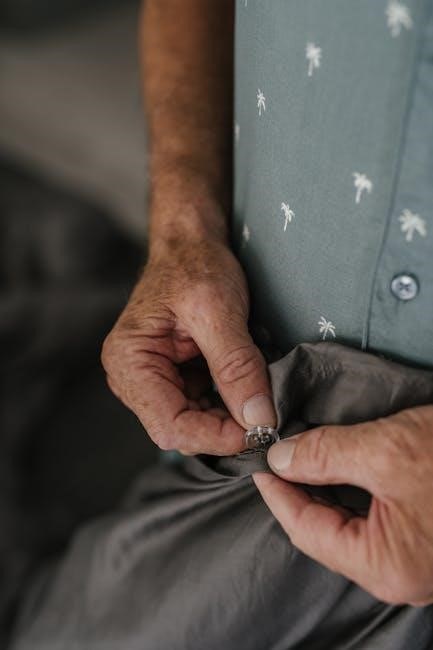Hip fracture rehabilitation is critical for restoring mobility and function, especially in older adults. It involves a structured, evidence-based approach to help patients recover and regain independence.
1.1 Importance of Rehabilitation in Hip Fracture Recovery
Rehabilitation is crucial for hip fracture recovery, as it restores mobility, reduces dependency, and prevents long-term complications. Early intervention helps patients regain strength, balance, and functional abilities, minimizing the risk of future falls and improving overall quality of life. A well-structured rehabilitation program addresses physical and emotional challenges, facilitating a return to pre-fracture activities. It also plays a key role in managing pain and promoting wound healing, ensuring a faster and more effective recovery process.
1.2 Goals of a Hip Fracture Rehabilitation Protocol
The primary goals of a hip fracture rehabilitation protocol are to restore functional independence, improve mobility, and reduce the risk of future complications. These goals are achieved through a structured, multidisciplinary approach that addresses pain management, strength, balance, and gait training. The protocol aims to enhance the patient’s ability to perform daily activities and return to their pre-fracture lifestyle. Additionally, it focuses on minimizing hospital readmissions and ensuring long-term recovery by addressing physical and emotional challenges. A well-designed protocol ensures personalized care tailored to the patient’s specific needs and promotes optimal outcomes.
Phases of Hip Fracture Rehabilitation
Hip fracture rehabilitation involves distinct phases, starting with acute care, progressing to subacute recovery, and culminating in post-acute rehabilitation, each tailored to promote healing and restore function.
2.1 Acute Phase Rehabilitation
The acute phase of hip fracture rehabilitation begins immediately after surgery, focusing on pain management, wound care, and early mobilization. This phase aims to stabilize the patient, prevent complications, and prepare for further recovery. Gentle exercises, such as ankle pumps and thigh squeezes, are introduced to maintain circulation and muscle tone. Patients are typically transitioned from bed to standing and short walks with assistance. The goal is to minimize bed rest and promote early movement, which is crucial for preventing muscle atrophy and improving functional outcomes. This phase lays the foundation for the subsequent stages of rehabilitation.
2.2 Subacute Phase Rehabilitation
The subacute phase of hip fracture rehabilitation begins once the patient is stable and focuses on progressive mobilization. During this phase, the emphasis shifts to strengthening exercises, balance training, and gait exercises to improve mobility. Patients typically start bearing weight as tolerated, with the assistance of walkers or canes. Physical therapists design tailored exercise programs to enhance muscle strength and restore functional movements. Pain management continues to be a priority, with adjustments made to ensure patient comfort. The subacute phase aims to transition patients from dependency to greater independence in performing daily activities, preparing them for the next stage of recovery.
2.3 Post-Acute Phase Rehabilitation
The post-acute phase of hip fracture rehabilitation focuses on transitioning patients to outpatient or home-based care. This phase emphasizes advanced strengthening exercises, gait training, and balance activities to restore pre-injury mobility. Patients work on functional tasks, such as climbing stairs and performing daily activities independently. The goal is to maximize independence and prepare patients for community reintegration. Therapy sessions may include proprioception exercises and resistance training to improve muscle endurance. Patient education on fall prevention and home safety is also prioritized during this phase to ensure long-term recovery and reduce the risk of future fractures.
Components of a Hip Fracture Rehabilitation Protocol
A comprehensive protocol includes weight-bearing status, range of motion exercises, strengthening, balance training, and gait exercises to restore mobility and functional independence in patients.
3.1 Weight-Bearing Status and Progression
Weight-bearing status is a critical component of hip fracture rehabilitation, determining how much pressure a patient can safely place on the affected leg. Initially, patients may be non-weight-bearing or partial weight-bearing, depending on the fracture type and surgical intervention. Progression to full weight-bearing is gradual, guided by pain tolerance and radiographic evidence of healing. Assistive devices like walkers or crutches are often used to support mobility during this phase. The goal is to minimize stress on the healing hip while promoting functional recovery. Adherence to weight-bearing guidelines is essential to prevent complications and ensure proper healing.
3.2 Range of Motion Exercises
Range of motion exercises are essential in hip fracture rehabilitation to maintain joint mobility and prevent stiffness. These exercises target the hip, knee, ankle, and foot, promoting flexibility and reducing the risk of contractures. Patients are encouraged to perform gentle movements within pain-free ranges, gradually increasing as healing progresses. Exercises can be done in sitting or lying positions, focusing on flexion, extension, abduction, and rotation. Consistent practice helps restore functional movement, preparing the patient for more advanced activities like strengthening and gait training. Early mobilization is key to avoiding long-term mobility limitations.
3.3 Strengthening Exercises
Strengthening exercises are crucial in hip fracture rehabilitation to restore muscle function and improve mobility. These exercises target key muscle groups, such as the glutes, quads, and hamstrings, to enhance stability and support the hip joint. Patients often perform isometric exercises, gluteal sets, and thigh squeezes to build strength without putting excessive strain on the fracture site. Resistance bands and progressive resistance exercises are introduced as healing advances. These exercises help restore muscle balance, reduce atrophy, and prepare the patient for functional activities, ensuring a safer transition to weight-bearing and gait training.
3.4 Balance and Proprioception Training
Balance and proprioception training are essential for restoring stability and coordination after a hip fracture. These exercises help patients regain awareness of body positioning and reduce the risk of falls. Techniques include single-leg stands, heel-to-toe walking, and wobble board or BOSU ball training. Patients often progress from supported to unsupported activities, fostering independence. Proprioceptive drills, such as mini squats or step-ups, enhance joint stability and muscle coordination. These exercises are tailored to individual recovery stages, ensuring a safe and effective return to daily activities and reducing long-term mobility limitations.
3.5 Gait Training
Gait training is a cornerstone of hip fracture rehabilitation, focusing on restoring normal walking patterns and improving mobility. Patients often begin with assisted walking using devices like canes or walkers, progressing to independent ambulation. Therapists emphasize proper weight-bearing techniques to avoid putting excessive strain on the healing hip. Exercises include marching in place, step-over-step walking, and navigating varied terrains. Strengthening the lower extremities and improving balance are integral to gait training, ensuring patients can safely move in their environments. The goal is to achieve a smooth, efficient gait that minimizes the risk of further injury and enhances overall functional independence.

Pain Management in Rehabilitation
Pain management is crucial in hip fracture rehabilitation, combining pharmacological and non-pharmacological strategies to optimize comfort and facilitate recovery. Medications, ice therapy, and gentle exercises are commonly used.
4.1 Pharmacological Pain Relief Options
Pharmacological pain relief is a cornerstone in managing hip fracture pain. Common options include acetaminophen for mild pain and opioids like tramadol or morphine for severe cases. Non-steroidal anti-inflammatory drugs (NSAIDs) such as ibuprofen can reduce inflammation and pain. However, long-term use of opioids is avoided due to risks of dependency. Additionally, nerve blocks or local anesthetics may be used during the acute phase to alleviate discomfort. The choice of medication depends on the patient’s overall health, pain intensity, and medical history, ensuring a balance between efficacy and safety.
4.2 Non-Pharmacological Pain Management Techniques
Non-pharmacological methods play a vital role in pain management during hip fracture rehabilitation. Techniques such as ice therapy can reduce swelling and discomfort. Breathing exercises and relaxation methods help alleviate anxiety and pain intensity. Physical therapy, including gentle exercises, improves mobility while minimizing pain. Additionally, transcutaneous electrical nerve stimulation (TENS) may be used to block pain signals. These methods are often combined with pharmacological approaches to optimize pain relief. A tailored, multidisciplinary strategy ensures effective pain management, enhancing patient comfort and recovery outcomes.
Wound Care and Surgical Site Management
Proper wound care involves cleaning, dressing, and monitoring for infection signs to promote healing and prevent complications after hip fracture surgery.
5.1 Post-Surgical Wound Care
Proper post-surgical wound care is essential for promoting healing and preventing infections after hip fracture surgery. This involves regular cleaning and dressing of the surgical site to maintain a sterile environment. Monitoring for signs of infection, such as redness, swelling, or pus, is critical. Patients should follow a structured wound care regimen, which may include the use of antimicrobial dressings to reduce the risk of complications. A multidisciplinary team, including nurses and surgeons, collaborates to ensure optimal wound management. Patient education on wound care techniques and infection prevention strategies is also vital to support recovery and minimize the risk of post-operative infections.
5.2 Managing Complications Related to Surgery
Managing complications after hip fracture surgery is crucial for a successful recovery. Common issues include infections, deep vein thrombosis, and hardware failure. Early detection and treatment are key to preventing long-term damage. Surgeons and healthcare providers monitor for signs of infection, such as fever or redness, and may prescribe antibiotics. Anticoagulants are often used to reduce the risk of blood clots. Imaging studies, like X-rays, help assess hardware placement and stability. A multidisciplinary team works to address complications promptly, ensuring the best possible outcomes and minimizing delays in rehabilitation. Proper management of surgical complications is vital for restoring mobility and overall patient health.
Multidisciplinary Approach to Rehabilitation
A coordinated team of healthcare professionals, including physical therapists, occupational therapists, and orthopedic surgeons, collaborates to create personalized rehabilitation plans, ensuring comprehensive care and optimal recovery outcomes for patients.
6.1 Role of Physical Therapists
Physical therapists play a pivotal role in hip fracture rehabilitation by designing and implementing exercise programs tailored to improve strength, mobility, and balance. They focus on pain-free movements, gradually increasing weight-bearing exercises to enhance functional recovery. Therapists also guide patients through gait training, helping them regain independence in walking. Additionally, they educate patients on proper body mechanics to prevent further injuries and promote long-term mobility. Regular assessments ensure progress is tracked, and treatment plans are adjusted accordingly to meet individual recovery goals and maximize outcomes.
6.2 Role of Occupational Therapists
Occupational therapists are essential in hip fracture rehabilitation, focusing on helping patients regain independence in daily activities. They assess patients’ ability to perform tasks like dressing, bathing, and cooking, adapting strategies to accommodate physical limitations. Home assessments are conducted to identify safety hazards and recommend modifications, such as grab bars or non-slip mats, to prevent falls. Occupational therapists also provide adaptive equipment to aid recovery and improve functional mobility. Their goal is to ensure patients can safely resume their daily routines and live independently, addressing both physical and environmental challenges throughout the recovery process.
6.3 Role of Orthopedic Surgeons
Orthopedic surgeons play a crucial role in hip fracture rehabilitation, primarily focusing on surgical intervention and post-operative care. They diagnose the type and severity of the fracture using imaging techniques like X-rays and determine the appropriate surgical procedure, such as hemiarthroplasty or intramedullary nailing. Post-surgery, they monitor healing progress, manage complications, and ensure proper alignment and stability of the hip joint. Surgeons also collaborate with other healthcare professionals to develop a comprehensive rehabilitation plan, addressing patient-specific needs and optimizing recovery outcomes. Their expertise ensures the foundation for successful rehabilitation, enabling patients to regain mobility and function effectively.
6.4 Role of Nurses and Healthcare Providers
Nurses and healthcare providers are essential in hip fracture rehabilitation, ensuring patient safety and comfort throughout recovery. They monitor post-surgical wounds, manage pain, and prevent complications like infections or blood clots. Nurses assist with mobility tasks, such as transferring and ambulation, while educating patients on proper techniques to avoid reinjury. They also provide guidance on medication adherence and lifestyle adjustments. Additionally, healthcare providers collaborate with therapists to implement rehabilitation plans, addressing the patient’s physical and emotional needs. Their continuous support and care are vital for optimizing recovery and helping patients regain independence and mobility effectively.

Patient Education and Compliance
Patient education is vital for adherence to rehabilitation protocols, empowering individuals to follow exercises and lifestyle adjustments. Educational materials guide recovery, enhancing compliance and recovery outcomes effectively.
7.1 Importance of Patient Adherence
Patient adherence to rehabilitation protocols is crucial for optimal recovery post-hip fracture. Consistent participation in exercises and therapy ensures better functional outcomes, reducing the risk of complications. Adherence fosters independence, enabling patients to regain mobility and perform daily activities. It also minimizes hospital readmissions and accelerates return to pre-fracture living conditions. Patients who comply with treatment plans often experience fewer long-term disabilities, improving overall quality of life. Adherence reinforces the effectiveness of rehabilitation strategies, making it a cornerstone of successful recovery and long-term health.
7.2 Educational Materials and Resources
Educational materials are essential for guiding patients through hip fracture rehabilitation. These resources include detailed exercise programs, recovery timelines, and wound care instructions. Visual aids like diagrams and videos help clarify complex exercises, ensuring proper technique. Printed leaflets and digital guides provide accessible information, empowering patients to take an active role in their recovery. Additionally, resources may cover nutrition advice and pain management strategies, promoting overall well-being. Accessible materials in multiple formats accommodate different learning preferences, ensuring all patients can understand and follow their rehabilitation plans effectively. These tools enhance patient engagement and improve adherence to recovery protocols.

Outcomes and Follow-Up
Outcomes and follow-up in hip fracture rehabilitation involve assessing recovery progress, ensuring functional restoration, and providing ongoing care to support long-term mobility and patient well-being effectively.
8.1 Measuring Rehabilitation Success
Measuring rehabilitation success involves assessing functional recovery, mobility, and pain reduction. Key metrics include improved gait, strength, and ability to perform daily activities. Patient-reported outcomes, such as quality of life surveys, are also crucial. Clinicians use standardized tools to evaluate progress, ensuring alignment with rehabilitation goals. Success is further defined by the patient’s ability to regain pre-fracture independence and safely return to their living environment. Regular follow-ups and assessments help track progress and adjust the rehabilitation plan as needed to optimize outcomes and long-term recovery.
8.2 Long-Term Follow-Up and Monitoring
Long-term follow-up ensures sustained recovery and prevents future complications. Regular check-ups with orthopedic specialists and physical therapists monitor joint health and functional abilities. Patients are evaluated for any signs of implant failure or degenerative changes. Monitoring also focuses on maintaining strength and mobility through continued exercises. Educational support helps patients adapt to lifestyle changes and prevent falls. Data from follow-ups informs improvements in rehabilitation protocols, ensuring better outcomes for future patients. Ongoing care is tailored to individual needs, promoting lasting independence and quality of life.

Future Directions in Hip Fracture Rehabilitation
Future advancements in hip fracture rehabilitation will focus on personalized care and innovative technologies. Wearable devices and AI-driven systems may predict recovery outcomes and tailor therapies. Regenerative medicine could enhance bone healing and reduce complications. Telehealth platforms will improve accessibility to rehabilitation services, especially for rural patients. Additionally, research into biomarkers and genetic factors may optimize treatment plans. A stronger emphasis on behavioral health will address mental barriers to recovery. These innovations aim to enhance patient outcomes, reduce hospital readmissions, and improve long-term functional independence for hip fracture survivors.

